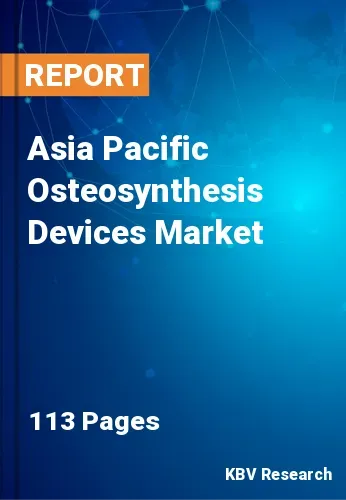The Asia Pacific Osteosynthesis Devices Market would witness market growth of 9.2% CAGR during the forecast period (2022-2028).
The commonly employed titanium plates cannot totally meet the need for solid fixation for good modeling in maxillofacial osteosynthetic operations due to their limitations in terms of imaging interference, mutagenesis effects, and visibility. It has been determined that using bioabsorbable osteosynthesis devices can significantly reduce or eliminate these constraints. Recent years have seen significant improvements in bioabsorbable osteosynthesis devices thanks to the use of bioactive osteoconductive materials and an accelerator substance. While making efforts on novel material advancements and newer product developments, major players in the bioabsorbable osteosynthesis market are increasingly concentrating on strengthening their hold in the supply chain to increase the market penetration of their existing bioabsorbable osteosynthesis devices.
The development of entire-body absorbable solutions has been emphasized by major participants in the market for bioabsorbable osteosynthesis devices. This led to the development of a novel method known as orientrusion, which improves the strength of polylactide while making it fully biocompatible and absorbable. Medial malleolar fractures have been successfully treated with bioabsorbable osteosynthesis implants made from orientruded polylactide.
The increasing spending of the people on healthcare facilities and the high awareness among people regarding these diseases and treatments would accelerate the growth of the regional vertebral compression fracture devices market over the forecast period. Additionally, the growing population of older people, along with the increasing prevalence of osteoporosis & arthritis, would support the growth of the regional vertebral compression fracture devices, which further drives the demand for the Osteosynthesis Devices Market in the region.
The China market dominated the Asia Pacific Osteosynthesis Devices Market by Country in 2021, and would continue to be a dominant market till 2028; thereby, achieving a market value of $981.5 million by 2028. The Japan market is estimated to grow a CAGR of 8.4% during (2022 - 2028). Additionally, The India market would experience a CAGR of 9.8% during (2022 - 2028).
Based on Type, the market is segmented into Internal (Screws & Plates, Wires & Pins, Intramedullary Rods & Nails, and Spinal Fixation Devices) and External (Fracture Fixation and Bone Lengthening). Based on Material, the market is segmented into Nondegradable and Degradable. Based on Fracture Type, the market is segmented into Patella, Tibia or Fibula, or Ankle, Hand & Wrist, Foot Bones & Vertebral Column, Hip, Pelvis, Clavicle, Scapula, or Humerus, Femur, Radius or ulna, and Others. Based on countries, the market is segmented into China, Japan, India, South Korea, Singapore, Malaysia, and Rest of Asia Pacific.
Free Valuable Insights: The Worldwide Osteosynthesis Devices Market is Projected to reach USD 14.2 Billion by 2028, at a CAGR of 8%
The market research report covers the analysis of key stake holders of the market. Key companies profiled in the report include DePuy Synthes, Inc. (J & J Company), Stryker Corporation, Zimmer Biomet Holdings, Inc., Smith & Nephew PLC, Medtronic PLC, Olympus Corporation, Globus Medical, Inc., Arthrex, Inc., Lepu Medical Technology Co., Ltd, and Life Spine, Inc.
By Type
By Material
By Fracture Type
By Country

Our team of dedicated experts can provide you with attractive expansion opportunities for your business.

